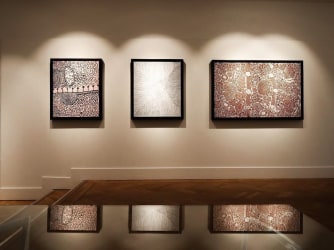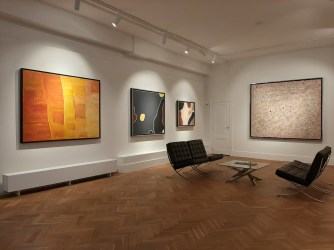Inloggen
Registreren
NL
Freddie Timms 1946 - 2017
Vertegenwoordigd door:
SmithDavidson Gallery
Freddie Timms werd geboren in Police Hole (ca. 1946-2017) en volgde in de voetsporen van zijn vader. Als jongeman werd hij veehouder op Lissadell Station. Na een bewogen leven op stations in East Kimberley vestigde hij zich in Frog Hollow, een kleine buitenpost op ongeveer 20 kilometer van de nieuw opgerichte gemeenschap Warmun. Hij werkte een tijdje als tuinman bij de opkomende Argyle Mine.
Hij begon in 1986 met schilderen, in het gezelschap van oudere kunstenaars zoals Rover Thomas en Hector Jandanay, die in die tijd al bekendheid verwierven. Waringarri Arts, in Kununurra, was net opgericht en Joel Smoker herkende Freddie's potentieel in zijn eerste onderscheidende doeken en merkte vanaf het begin zijn zelfverzekerde beheersing van het medium op. In de daaropvolgende 25 jaar werd Timms beroemd door het afbeelden van locaties die verband hielden met de ontheemding van zijn volk en het verlies van hun land. Maar in plaats van openlijke politieke statements over de wreedheid van de kolonisatie of de onteigening, worden zijn intieme kaartachtige interpretaties van het land meestal weergegeven met een ervaringsgerichte inslag.
Timms eerste tentoonstelling bij Deutscher, Gertrude Street, in 1989, kreeg lovende kritieken met zijn meesterwerk 'Mandangala, North Turkey Creek'. In wat leek op een nieuw en prachtig gevoel voor onregelmatige geometrie, beeldden zachte maar gedurfd gedefinieerde kleurvlakken het gebied van Glen Hill en de Argyle Diamond Mine ten noorden van Turkey Creek af. Halverwege de jaren negentig reisde Freddie vaak met de Kimberley-meester Rover Thomas en schilderde hij een groot aantal werken voor de Kimberley Art Gallery via de samenwerking met de Warmun Community, waaronder twee van zijn meest waardevolle werken op veilingen. Beide werken hanteren een breder en kleurrijker palet dan de natuurlijke aardpigmenten die veel worden gebruikt door andere kunstenaars uit Oost-Kimberley.
Bezoek onze website smith-davidson.com voor meer informatie.
Hij begon in 1986 met schilderen, in het gezelschap van oudere kunstenaars zoals Rover Thomas en Hector Jandanay, die in die tijd al bekendheid verwierven. Waringarri Arts, in Kununurra, was net opgericht en Joel Smoker herkende Freddie's potentieel in zijn eerste onderscheidende doeken en merkte vanaf het begin zijn zelfverzekerde beheersing van het medium op. In de daaropvolgende 25 jaar werd Timms beroemd door het afbeelden van locaties die verband hielden met de ontheemding van zijn volk en het verlies van hun land. Maar in plaats van openlijke politieke statements over de wreedheid van de kolonisatie of de onteigening, worden zijn intieme kaartachtige interpretaties van het land meestal weergegeven met een ervaringsgerichte inslag.
Timms eerste tentoonstelling bij Deutscher, Gertrude Street, in 1989, kreeg lovende kritieken met zijn meesterwerk 'Mandangala, North Turkey Creek'. In wat leek op een nieuw en prachtig gevoel voor onregelmatige geometrie, beeldden zachte maar gedurfd gedefinieerde kleurvlakken het gebied van Glen Hill en de Argyle Diamond Mine ten noorden van Turkey Creek af. Halverwege de jaren negentig reisde Freddie vaak met de Kimberley-meester Rover Thomas en schilderde hij een groot aantal werken voor de Kimberley Art Gallery via de samenwerking met de Warmun Community, waaronder twee van zijn meest waardevolle werken op veilingen. Beide werken hanteren een breder en kleurrijker palet dan de natuurlijke aardpigmenten die veel worden gebruikt door andere kunstenaars uit Oost-Kimberley.
Bezoek onze website smith-davidson.com voor meer informatie.
Kunstwerken
Articles
Media
Highlights
Over de kunstenaar
In collectie van
Tentoonstellingen
Marktpositie
CV
Aangeboden kunstwerken van Freddie Timms
Articles on Freddie Timms
Media

Portret van Freddie Timms
Tentoonstellingen
In museumcollectie van:
National Gallery of Victoria, Melbourne, Australia
Art Gallery of New South Wales
Marktpositie
Sinds zijn eerste tentoonstelling in 1989 kreeg Freddie Timms internationale erkenning voor zijn kunst. In 1999 werd hij vertegenwoordigd door een van Sydney's meest gerespecteerde kunsthandelaren, Frank Watters. Zijn tentoonstelling van dat jaar verkende de geschiedenis van een inheemse struikrover genaamd Major, die in 1908 door de politie werd neergeschoten nadat hij blanken had gedood bij Blackfeller Creek. Timms verliet uiteindelijk Watters Gallery en keerde terug naar Kimberley om met hulp van kunstenaar en kunsthandelaar Tony Oliver de Jirrawun Aboriginal Art Corporation op te richten.
Timms' werk is opgenomen in belangrijke openbare collecties in Australië, zoals de Art Gallery of New South Wales, de National Gallery of Victoria en de Art Gallery of South Australia. Zijn schilderijen waren jarenlang te zien in de National Aboriginal Art Award Exhibition in het Museum and Art Gallery of the Northern Territory in Darwin. Zijn werk was ook te zien op tentoonstellingen in het Louisiana Museum, Denemarken in 1994 en 1996, en op de tentoonstelling 'Prism Contemporary Australian Art' in het Bridgestone Museum of Art in Tokio in 2006.
Timms' werk is opgenomen in belangrijke openbare collecties in Australië, zoals de Art Gallery of New South Wales, de National Gallery of Victoria en de Art Gallery of South Australia. Zijn schilderijen waren jarenlang te zien in de National Aboriginal Art Award Exhibition in het Museum and Art Gallery of the Northern Territory in Darwin. Zijn werk was ook te zien op tentoonstellingen in het Louisiana Museum, Denemarken in 1994 en 1996, en op de tentoonstelling 'Prism Contemporary Australian Art' in het Bridgestone Museum of Art in Tokio in 2006.
CV
Selected Collections
National Gallery of Australia, Canberra, Australia
Art Gallery of New South Wales, Sydney, Australia
National Gallery of Victoria, Melbourne, Australia
Art Gallery of Western Australia, Perth, Australia
Art Gallery of South Australia, Adelaide, Australia
Gabrielle Pizzi Collection, Melbourne, Australia
Kelton Foundation, Santa Monica, USA
Art Bank, Sydney, Australia
Wollongong Art Gallery, Wollongong, Australia
The Holmes á Court Collection, Perth, Australia
The Collection of Colin and Elizabeth Laverty, Sydney, Australia
Aboriginal Art Museum, Utrecht, The Netherlands
Selected Exhibitions
2006 - 'Prism Contemporary Australian Art', Bridgestone Museum of Art, Japan
2006 - 'Interesting Times', Museum of Contemporary Art, Australia
2003 - 'True Stories: Art of the East Kimberley', Art Gallery of New South Wales, Australia
2002 - 'Blood on the Spinifex', The Ian Potter Museum of Art, The University of Melbourne, Australia
2001 - The 18th National Aboriginal Art Award Exhibition, Museum and Art Gallery of the Northern Territory, Australia
2000 - The 17th National Aboriginal Art Award Exhibition, Museum and Art Gallery of the Northern Territory, Australia
1993/4 - 'ARATJARA', Art of the First Australians, Australia
1993 - 'Images of Power', Aboriginal Art of the Kimberley, National Gallery of Victoria, Australia
1992 - The Ninth National Aboriginal Art Award Exhibition, Museum and Art Gallery of the Northern Territory, Australia
1991 - The Eighth National Aboriginal Art Award Exhibition, Museum and Art Gallery of the Northern Territory, Australia
1990 - The Seventh National Aboriginal Art Award Exhibition, Museum and Art Gallery of the Northern Territory, Australia
1989 - 'Turkey Creek: Recent Work;, Deutscher Gertrude Street, Australia
National Gallery of Australia, Canberra, Australia
Art Gallery of New South Wales, Sydney, Australia
National Gallery of Victoria, Melbourne, Australia
Art Gallery of Western Australia, Perth, Australia
Art Gallery of South Australia, Adelaide, Australia
Gabrielle Pizzi Collection, Melbourne, Australia
Kelton Foundation, Santa Monica, USA
Art Bank, Sydney, Australia
Wollongong Art Gallery, Wollongong, Australia
The Holmes á Court Collection, Perth, Australia
The Collection of Colin and Elizabeth Laverty, Sydney, Australia
Aboriginal Art Museum, Utrecht, The Netherlands
Selected Exhibitions
2006 - 'Prism Contemporary Australian Art', Bridgestone Museum of Art, Japan
2006 - 'Interesting Times', Museum of Contemporary Art, Australia
2003 - 'True Stories: Art of the East Kimberley', Art Gallery of New South Wales, Australia
2002 - 'Blood on the Spinifex', The Ian Potter Museum of Art, The University of Melbourne, Australia
2001 - The 18th National Aboriginal Art Award Exhibition, Museum and Art Gallery of the Northern Territory, Australia
2000 - The 17th National Aboriginal Art Award Exhibition, Museum and Art Gallery of the Northern Territory, Australia
1993/4 - 'ARATJARA', Art of the First Australians, Australia
1993 - 'Images of Power', Aboriginal Art of the Kimberley, National Gallery of Victoria, Australia
1992 - The Ninth National Aboriginal Art Award Exhibition, Museum and Art Gallery of the Northern Territory, Australia
1991 - The Eighth National Aboriginal Art Award Exhibition, Museum and Art Gallery of the Northern Territory, Australia
1990 - The Seventh National Aboriginal Art Award Exhibition, Museum and Art Gallery of the Northern Territory, Australia
1989 - 'Turkey Creek: Recent Work;, Deutscher Gertrude Street, Australia
Gratis Online Magazine
Artikelen, interviews, shows & events. Wekelijks bezorgd in uw mailbox.






